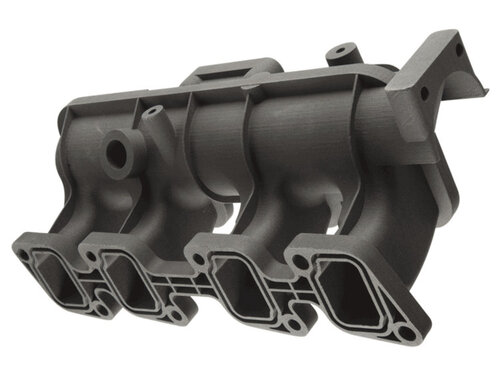Introduction
With over 15 years experience in manufacturing, Micah Chaban has developed a deep expertise with cutting edge technologies, including additive manufacturing. As a Founder and VP of Sales and Marketing at RapidMade, he has helped countless businesses leverage 3D printing to streamline production, reduce costs, and improve product performance. In this interview, Micah shares his insights on HP Jet Fusion 3D printing materials and how they are transforming modern manufacturing.
What makes HP Jet Fusion 3D printing materials unique compared to other additive manufacturing materials?
HP Jet Fusion materials stand out for their balance of strength, detail, and cost efficiency. The technology itself is a game-changer because it allows for high-volume production of durable parts with incredible accuracy and detail. Unlike traditional 3D printing methods like FDM or SLA, which have limitations in isotropic strength or surface finish, HP’s Multi Jet Fusion (MJF) process creates fully dense parts with properties comparable to injection molding. These powderbed technologies offer superior surface finish and require a fraction of the post-processing labor.
Another major advantage is material reusability. HP’s High Reusability PA 12 and Polypropylene, for example, can be reused at rates up to 80–90%, significantly reducing material waste and overall production costs. That’s a big deal for companies looking to scale production efficiently.
Absolutely. HP offers a range of materials. These materials are non-toxic and suitable for a wide range of consumer, commercial and industrial applications.
PA 12, or Polyamide 12 – more commonly known as Nylon 12 is a strong and durable nylon that’s widely used in aerospace, automotive, and medical industries. It’s got excellent chemical resistance and holds its shape well, which makes it great for things like enclosures, housings, and detailed parts where precision matters. This is the workforce material suitable for most applications.
Then there’s PA 12 Glass Beads, or PA 12 GB, which is a glass reinforced version of PA 12. It’s mixed with 40% glass, so it’s much stiffer and more dimensionally stable. That makes it perfect for fixtures, jigs, brackets, and structural components that need to hold their shape under stress.
PA 11 is another option, and compared to PA 12, it’s a lot more flexible and impact-resistant. It’s actually made from renewable castor oil, so it’s a more sustainable choice too. You’ll often see it used in prosthetics, sporting goods, and snap-fit designs—anything that needs to bend without breaking.
Polypropylene, or PP, is a really lightweight, chemically resistant material that’s also weldable. It’s commonly used in fluid handling systems, medical devices, and automotive applications. One of the biggest advantages of PP is cost efficiency because it has the lowest cost powder and allows for incredibly high powder reuse rates – 90%, which helps keep production costs down.
And finally, there’s TPU, or Thermoplastic Polyurethane. If you need something flexible and tough, this is the way to go. It’s great for gaskets, seals, protective gear—anything that needs to have a rubber-like feel but also hold up to wear and tear. It’s got fantastic abrasion resistance and can bend over and over again without failing.
Each of these materials has a unique strength, and the best choice depends on your specific application needs.
How does material selection impact the final performance of a 3D-printed part?
Material selection is critical because it determines the mechanical properties, environmental resistance, and long-term durability of the part. For example, if you’re designing a medical device that will come into contact with chemicals, you’ll want to use PP because of its high chemical resistance. If your part needs to handle high stress and impact, PA 11 or TPU are a better options due to flexibility and toughness.
Another key factor is heat resistance. If your part will be exposed to high temperatures, you’ll want something like PA 12 GB, which has a higher heat deflection temperature compared to other materials.
The bottom line is that selecting the right material ensures the part performs as expected under real-world conditions. That’s why we work closely with customers at RapidMade to help them make the best choice based on their needs.
How does HP Jet Fusion compare to traditional manufacturing methods like injection molding?
It depends on the application, but HP Jet Fusion offers some significant advantages. The biggest one is speed—3D printing can go from design to finished part in hours or days, whereas injection molding requires tooling that can take weeks or even months. That makes Jet Fusion ideal for rapid prototyping, low-to-medium production runs, and even custom end-use parts.
Cost is another factor. For large-scale production, injection molding is still more cost-effective per part, but when you factor in tooling costs, HP Jet Fusion often becomes the better choice for smaller production runs. Plus, design flexibility is unmatched—you can create complex geometries that would be impossible or extremely expensive with injection molding.
What industries are benefiting the most from HP Jet Fusion materials?
HP Jet Fusion materials are making a big impact across a lot of industries, but there are a few where we’re seeing the most growth.
Aerospace and automotive companies are really taking advantage of these materials because they need parts that are both lightweight and strong. PA 12 and PA 12 GB are perfect for that, whether it’s functional components, housings, or brackets that have to hold up under stress.
In the medical and healthcare space, we’re seeing a lot of interest in PP and PA 11. These materials work great for things like prosthetics, medical devices, and even surgical guides because they’re biocompatible and highly resistant to chemicals.
Consumer goods companies are also jumping in, especially with TPU. It’s flexible, tough, and great for things like custom footwear, protective gear, and other products that need a bit of stretch and durability.
And of course, in the manufacturing and industrial world, PA 12 GB is a go-to material for making jigs, fixtures, and assembly tools. It’s rigid, holds its shape well, and can stand up to heavy use on the factory floor.
What advice would you give to companies looking to implement HP Jet Fusion technology?
Start with the end goal in mind. Think about what you need the part to do—does it need to be strong, flexible, heat-resistant, or chemical-resistant? That will guide your material selection.
Next, leverage design for additive manufacturing (DfAM) principles. 3D printing allows for incredible design freedom, but you need to optimize parts to take full advantage of it. Reducing material usage, consolidating assemblies, and using lattice structures can improve part performance and reduce costs.
Finally, work with an experienced partner. At RapidMade, we help businesses navigate material selection, optimize designs, and scale production efficiently. Having a knowledgeable team on your side can make all the difference in getting high-quality, cost-effective parts.
Conclusion: Why Choose RapidMade for HP Jet Fusion 3D Printing?
HP Jet Fusion technology is revolutionizing manufacturing, but success depends on using the right materials and optimizing designs for production. At RapidMade, we specialize in helping companies make the most of 3D printing by providing expert guidance, high-quality materials, and scalable production solutions.
If you’re ready to explore how HP Jet Fusion 3D printing can improve your manufacturing process, contact us today.
🔗 Visit RapidMade.com to learn more!




